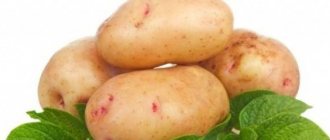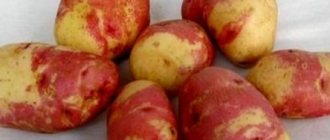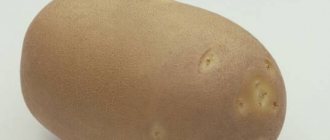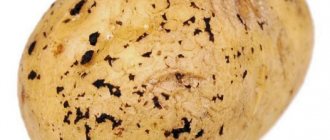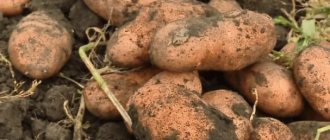Description of the potato variety Zekura
Zekura potatoes were obtained during the work of German breeders from Hamburg. In the 90s of the 20th century, the culture was successfully tested in different countries, including Russia. In 1997, potatoes were included in the State Register. The Zekura variety is recommended for cultivation in most regions of the Russian Federation:
- Central;
- Far Eastern;
- southern regions;
- Western Siberia.
Characteristic:
- purpose - dining room. Starch content from 13 to 18%;
- mid-season – 80–100 days;
- plant type – intermediate.
The bush is quite compact, so you can leave a small interval of 55–60 cm between the furrows. The leaves are of a simple type, small in size, light green in color. The corollas are small, rich red with shades of purple. The roots go deep and are well developed.
Each Zekura potato bush, with proper care, produces up to 20 tubers
The sizes of root crops are average: length 5–9 cm, weight 50–120 g, large ones are often found. The shape is oblong. The peel and pulp are yellow. The surface of the tuber is smooth, the eyes are practically invisible. The pulp is boiled and crumbly, which is explained by the high mass fraction of starch. The taste is good, the consistency is pleasant.
Important! According to the Russian register of the State Variety Commission, the commercial yield of Zekura potato root crops is 79–96%.
Therefore, the variety can be grown not only on private plots, but also on farm fields.
Zekura potatoes are valued for their interesting taste and good yield
Advantages and disadvantages
Pros:
- early ripening friendly harvests;
- ease of cultivation and digging;
- resistance to scab and leaf curl;
- good keeping quality;
- a large number of tubers under 1 bush;
- excellent taste and product characteristics;
- adaptability to northern conditions;
- dietary value of the product;
- suitability for cultivation in different climates.
Minuses:
- demanding on soil quality (maximum potential on fertilized soils);
- the importance of regular hydration.
Characteristics of the potato variety Zekura
Thanks to its developed root system, the crop is drought-resistant. Zekura potatoes do not tolerate return frosts. Therefore, it is better to plant after the May holidays. The shelf life of root crops is 97–98%, which allows you to preserve the harvest until late spring. Tubers can be transported over long distances. Area of application: for boiled dishes, especially for mashed potatoes, potato pancakes, as well as for baking and stewing.
Productivity
Zekura potato tubers become ripe on average 3 months from the date of germination. The crop has good yield:
- 1.1–1.6 kg per plant;
- 2.2–3.2 kg per square meter;
- 220–320 kg per hundred square meters.
The highest yield of potatoes of the Zekura variety was 365 kg per 100 m2. The record was recorded in the Oryol region. In order to consistently obtain a large number of large tubers, it is necessary to follow several rules of agricultural technology:
- Additional watering during drought (weekly).
- Hilling up - at least three times per season.
- Feeding - three times during the summer.
- Loosen the soil regularly, especially after watering and rain.
- Treatment of Zekura potato bushes with insecticides if necessary (to kill insects).
Advantages and disadvantages
Zekura potatoes have a pleasant taste and consistently high yields. This is one of the few varieties that has strong immunity to dangerous diseases, such as late blight.
The originator stated that Zekura potatoes have a good shelf life for 7–8 months in a cold room
Pros:
- excellent taste, delicate consistency;
- stable yield;
- high disease resistance;
- drought resistance;
- long-term storage;
- universal purpose;
- presentation of tubers;
- transportation resistance.
Minuses:
- may suffer from spring frosts;
- Due to starchiness, it loses its shape when fried.
How to grow a variety on the site
Zekura potatoes were bred specifically for cultivation in European countries , so it shows the best results in the regions of the Central Black Earth Region of Russia. During the experiment, it was possible to find out that the variety quickly adapts to different climates and soil types, due to which it is successfully cultivated in areas with cold climates.
Zekura is drought-resistant and easily tolerates excessive soil moisture . The plant is characterized by being unpretentious in care. It responds to moderate watering and fertilizing by increasing productivity.
Interesting things on the site:
Mid-early high-yielding variety "Belmondo"
The ideal potato variety to purchase for the winter: “Jellie”
Description and characteristics of the potato variety "Laperla"
Dates, scheme and rules of planting
Zekura has enviable resistance to most nightshade diseases , so it does not need to treat the tubers before germination.
But for preventive purposes, gardeners soak the seeds in a pink solution of potassium permanganate and Fitosporin, and 24 hours before planting they treat them with Epin or Zircon to stimulate growth. selected area is dug up , harrowed and fertilized with mullein - 10 liters per 1 m². The planting time depends on climatic conditions. In the southern regions, planting work begins in late April, in the middle zone - in the first ten days of May, in the north - in the middle or at the end of May. The optimal soil temperature is +10…+12°C.
The plant has a powerful rhizome, so the tubers are planted at a distance of 40-50 cm . Planting depth is 10 cm on sandy and sandy loam soils, and 6-8 cm on loam and chernozem.
Care
The bushes can withstand dry periods, but a long-term lack of moisture is detrimental to them .
The best solution is to organize drip irrigation on the site. This is especially true for the southern regions of the country. In temperate climate areas, plantings are watered as needed. Loosening and weeding are carried out during the period of active growth of green mass .
To do this, use saps, hoes, and flat cutters in small areas. Industrial potato growing is not complete without cultivators and walk-behind tractors, which greatly facilitate the care of plantings. Hilling is a mandatory procedure that allows you to protect the tubers from the cold , saturate the rhizome with oxygen, and facilitate access to nutrients. The first hilling is carried out after the appearance of sprouts 10–15 cm high, the second – after 2–3 weeks.
The originator did not provide recommendations for applying fertilizers , so farmers rely on the standard scheme:
| Application period | Top dressing | |
| I portion | 14 days after germination | 20 g of dry chicken manure, 25 g of urea per 10 liters of water at room temperature, at the root - 500 ml |
| II portion | Before budding | 15 g of superphosphate and potassium sulfate per 10 liters of water, at the root - 500 ml |
| III portion | During the flowering period | 2 g sodium humate per 10 l, for spraying bushes |
Nuances of cultivation and possible difficulties
To successfully grow potatoes on a plot, it is recommended to observe crop rotation . The best crop predecessors: cucumbers, zucchini, cabbage, onions, garlic, beets, peas, beans, lupine, flax, wheat, rye, oats.
The Zekura variety is prone to degeneration , so timely renewal of planting material (once every 7–8 years) guarantees high yield and marketability of tubers.
In addition to traditional cultivation, Vladimir Kartelev’s method is often used . A famous scientist and agronomist suggests cultivating potatoes without tillage. Instead of soil, use grass, which serves as an excellent fertilizer and prevents late blight infection.
The cut grass is left to dry outside, then small stacks are formed and stored in the woodshed. In late autumn, the preparations are laid out on the site. You can use hay and straw.
In the spring, 30% of the area is plowed, weeds are removed and even rows with depressions are formed. Manure is placed in the furrows and covered with soil. Next, lay the tubers and beans, sprinkle with wood ash and soil. No need to compact. After the appearance of bushes 10 cm high, hilling is carried out.
Interesting fact. Marie Antoinette used potato flowers as hair decoration. Later, Louis XVI supported her hobby and decorated her boutonniere with them, helping to popularize flowers among French aristocrats.
Diseases and pests
Zekura potatoes have strong immunity and are genetically protected from potato cancer, golden nematode, leaf curl virus, late blight of leaves and tubers, glandular spot, viruses A and Y. The
variety has moderate resistance to common scab , but with proper care the fungus has no chance for development. Scab develops in calcareous and alkaline soil at air temperatures above +25°C. The fungus penetrates the tubers through microcracks in the skin. Hard, rough spots of irregular shape appear on the surface.
Reference. Potato varieties with thin pink skin are susceptible to common scab.
Helps reduce the risk of infection:
- watering the bushes during the period of active growth of tubers;
- deep planting in the ground;
- normalization of soil pH;
- acidification of alkaline soil - 40 g of ammonium sulfate per 10 liters of water;
- pre-planting seed treatment;
- crop rotation;
- minimal use of fresh manure;
- storing potatoes in a cool, dry place.
Wireworms and Colorado potato beetles pose a danger to potato plantings
The larvae of the click beetle (wireworm) settle in plant debris. Timely removal of tops and weeds, deep spring plowing of the area and deoxidation of the soil will help get rid of the pest.
To reduce acidity, 500 g of slaked soda or lime and 10 liters of aqueous suspension of wood ash are added per 1 m².
Adding nitrogen-containing fertilizers to the soil will help repel the larvae.:
- 30 g ammonium sulfate or ammonium chloride per 1 m²;
- 20 g of ammonium nitrate per 1 m².
Highly effective against wireworms:
- treatment with chemicals “Aktara”, “Bazudin”, “Prestige”, “Diazinon”, “Grom”, “Gromoboy”, “Zemlin”, biological preparation “Nemabakt”;
- watering the holes with a 1% solution of potassium permanganate before planting;
- adding onion peels to each hole;
- watering the plants with herbal infusion - 200 g of nettle, 100 g of dandelion and coltsfoot, 50 g of celandine per 5 liters of warm water, leave for 24 hours;
- planting near the beds of marigolds.
Used to repel the Colorado potato beetle:
- dusting bushes with gypsum, lime, corn flour, birch ash;
- spraying with “Corado”, “Commander”, “Bitobaxillin”;
- spraying with infusion of walnuts or sunflower flowers - 100 g of raw materials per 10 liters of water;
- planting garlic, marigolds, nasturtium, calendula, coriander on the plot.
Landing rules
For planting Zekura potatoes, fertile sandy loam or loamy soil with a neutral or slightly acidic reaction (pH from 6.5 to 7.0) is suitable. It is optimal if the area is flat, without drops. The place should be well lit.
They begin to prepare the land in the fall:
- The area is cleared.
- Dig to a depth of 35 cm.
- Apply complex mineral (30–40 g per 1 m2) or organic (compost, humus – 4–7 kg per 1 m2) fertilizer.
- If the soil is heavy, add sawdust or coarse sand: 500–700 g per 1 m2.
Attention! Zekura potatoes are planted on May 10–20.
By this time, the earth will have time to warm up to +10 °C, and the likelihood of return frosts will be minimal. A month before this, the tubers are transferred to a lighted room, laid out in several layers on the floor and stored at a temperature of +12–15 °C. Potatoes can be irrigated with water periodically for better germination. In this case, treatment with fungicides is not necessary, since the variety has good immunity to fungal infections.
The algorithm for planting Zekura potatoes is standard:
- In the prepared area, furrows are formed at intervals of 60 cm, in a north-south orientation.
- Place 2 tubers in a planting hole 8–10 cm deep.
- A distance of 30–50 cm is maintained between the holes.
- You can dust the tubers with ash and then cover them with soil.
Mandatory measures for caring for potatoes
7 days after planting potatoes in the ground, surface tillage should be performed. To do this, you need to loosen it a little with a rake to provide the tubers with air flow. If the potatoes were planted in early or mid-spring, then to prevent them from being destroyed by frost, it is necessary to completely hill up the bushes. According to farmers, at least three hillings should be performed in one season.
Mulching the soil is no less important. This will protect the tubers from negative environmental factors, as well as reduce the monetary and physical costs of watering, weeding and loosening the soil. Mulching slows down the deep heating of the soil and prevents moisture evaporation. In this case, you can use pine branches, humus or sawdust.
If mulching was not done on time and the soil began to dry out, then in order for Zekura potatoes to grow normally, it is necessary to irrigate and water. At the same time, it is very important that the water saturates not only the soil, but also moistens the bush itself. After the moisture reaches the potato tubers, it is very important to loosen the soil. This will not only increase the flow of oxygen to all tubers, but will also prevent the formation of a kind of crust on the soil, which will impede the penetration of moisture and worsen the quality of watering.
Read also: How to properly prune raspberries in the fall - instructions for beginners
Features of cultivation
Growing Zecura potatoes is easy. The basic rules are no different from the agricultural technology of domestic varieties:
- Watering is needed weekly, but only during prolonged drought. Water is poured into the rows or under the root of the bush - 3 liters for each plant.
- The next day after watering (or rain), it is advisable to loosen the surface layer of soil. It is important to prevent the earth from cracking.
- Hilling is carried out 3 times. First after emergence (15 cm), then twice more with a break of 3 weeks.
- Zekura potatoes are also fertilized three times. Before the first hilling, give an infusion of mullein. Superphosphate with potassium salt and wood ash is sealed during the appearance of buds and blossoming of flowers.
- Weed regularly, preventing weeds from overwhelming the bushes.
In large areas, potatoes are planted using a walk-behind tractor.
Reviews
Reviews about the Zekura variety are more than positive . The culture is valued for its undemandingness to growing conditions, high productivity and excellent taste.
Valentin, Kirov : “In the summer I move to the dacha and devote all my time to growing vegetables.
Every year I set aside a small area for planting potatoes. I consider Zekura one of the best varieties. It is very easy to care for plantings. I water the bushes only when there is a long drought and feed them with humates.” Boris, Nizhny Novgorod : “Zekura is a reliable and undemanding variety.
The plant practically does not suffer from anything, except that scab appears occasionally. But I immediately throw away the infected tubers, and the spores do not develop in the cellar. In the spring, I soak the tubers in potassium permanganate before planting.” Inga, Borisoglebsk : “This amazing German variety has been pleasing us for many years, remaining on the list of favorites. Tasty and aromatic yellow potatoes cook quickly, but do not turn into mush. We prepare all kinds of dishes from it and store it in the basement until spring. The variety resists most diseases, and we get rid of colorados by treating them with ash or infusion of walnut leaves.”
Pests and diseases
The immunity of the Zekura variety is strong. The culture successfully resists common diseases and pests. It withstands late blight on tubers and tops. Resists leaf curl, is rarely affected by viruses type Y and A. Also has immunity to scab, glandular spot, cancer and potato nematode.
Therefore, it is not necessary to carry out preventive dressing of tubers and treatment of grown tops with fungicides. As a last resort, this can be done at the beginning of the season, after germination. Other preventative measures are also applied:
- You cannot plant tubers in the same field for three years in a row.
- You should exclude planting in an area where last season there were Solanaceae - potatoes of any variety, tomatoes, eggplants and other crops.
- After the emergence of shoots (15–20 cm), you need to dust them with ash. It is advisable to carry out the procedure several times a season.
- Place sawdust between furrows.
- Mulch the plantings with straw.
- Pour a weak solution of birch tar into the rows.
To destroy insect colonies, you can treat Zekura potato bushes with a powerful insecticide (one to choose from):
- "Biotlin";
- “Agravertine;
- "Match";
- "Vertimek";
- "Green Soap";
- "Colorado" and others.
Advice! The best predecessors of potatoes are legumes, melons, wheat, cabbage and cucumbers.
Care
Like any culture, Zekura loves good care.
Potatoes love timely watering. Water it three times a season. The first time when the first shoots appear, the second time during the beginning of flowering and the last time before its end. It is not recommended to water the crop after flowering, as there is a high probability of late blight.
When the sprouts grow 15 cm, the first hilling is carried out. After about 2 weeks, the potatoes are hilled a second time.
Harvesting and storage
If the planting date and cultivation rules are observed, the Zekura potato crop is harvested in the first ten days of August. This can only be done in dry weather. The tubers are laid out on the furrows and allowed to dry a little.
Then they are sorted and put into bags.
For the first 15–20 days, the tubers are stored in a dark room at a temperature of no more than +15 °C
For the winter, potatoes are sent to the cellar or vegetable store. There they maintain a constant temperature of +2–4 °C and humidity of 70–80%.
Damaged, too large and very small root vegetables are best consumed first.
Origin story
The Zekura potato was developed by German breeders. The goal of their work was to obtain a variety that would meet the following criteria:
- short ripening period;
- fairly high resistance to diseases, pests and adverse environmental conditions;
- good taste;
- long shelf life of potatoes.
After several months, and maybe even years of painstaking work, the Zekura variety was developed, which has been successfully grown in Russia and the CIS countries for more than 20 years.
Necessary conditions for growth and fruiting
For proper growth and development of vegetable crops, level, sunny land plots are selected. The predecessors that grew on these soils play an important role.
Potatoes are planted in open ground after onions, garlic, herbs, cucumbers and legumes. Also, a suitable soil composition remains after beets and peppers.
After tomatoes and sunflowers, there is a danger of fungal and viral diseases developing in the soil. These crops are unacceptable predecessors for potatoes.



